 Climate chamber, Snijders Scientific, The Netherlands
Climate chamber, Snijders Scientific, The Netherlands
The climate chamber is designed to be used for a wide range of research applications like seed germination, protoplasm cultivation, tissue culture, plant growth, Arabidopsis tests, celular division and many other within life sciences with the possibility to imitate the natural environmental conditions.
With a total volume of 432 liters, as well as a usable area/shelf of 0.36 m2 , the chamber allows to use of an increased number of experimental replicates. The parameters that can be configured are: temperature (between +5 and +40°C), light intensity (between 0 and 10.000 Lx), humidity (between 5 and 100%). The cycle programming allows experimental standardization; up to 50 programs, as well as up to 99 segments/program.
Thermal imaging equipment Lemnatec Scanalyzer PL, LemnaTec GmbH, Germany
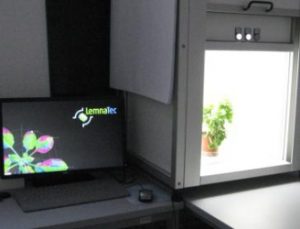
The system allows the analysis of the organisms’ development phenotypic parameters in non-destructive conditions. This process is possible by using video and IR sensors placed above the item. Also, a double lighting system (top, back) ensures the necessary conditions for performing analyzes. Captures are made at a frame rate of 3.75 – 7.5 fps, allowing real-time observations. The categories of organisms that can be traced are varied; from microorganisms (bacteria, fungi) grown in Petri dishes to higher plant organisms (plants) grown in large containers. In these organisms, different processes can be quantified, such as the accumulation of biomass or the evolution of the leaf surface.
Kjeldahl VELP System for the determination of total nitrogen and protein
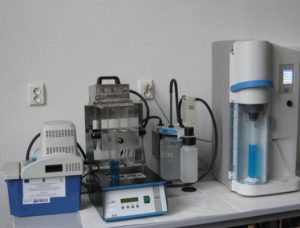 The system consists of three complementary units for the determination of total nitrogen content from mineral, microbial, vegetable or animal sources, having the ability to use liquid or solid samples. The DK6 Velp Scientifica digestion unit consists of an electronically controlled 6-station aluminum block. The temperature of the block can be adjusted between 45-450°C, through 20 programs and 4 temperature and time ramps. The fume neutralization system (SMS scrubber) coupled with the water recirculation pump (JP) ensures the condensation and neutralization of fumes from the digestion process. The UDK 139 Semi-Automatic Kjeldahl Distillation Unit allows a rapid distillation of the digested solutions. The unit allows the scheduling of distillation time, automatic addition of sodium hydroxide and water, also the emptying of the tube. The degree of nitrogen recovery is over 99.5%. The distillation rate is 35-40 ml/min.
The system consists of three complementary units for the determination of total nitrogen content from mineral, microbial, vegetable or animal sources, having the ability to use liquid or solid samples. The DK6 Velp Scientifica digestion unit consists of an electronically controlled 6-station aluminum block. The temperature of the block can be adjusted between 45-450°C, through 20 programs and 4 temperature and time ramps. The fume neutralization system (SMS scrubber) coupled with the water recirculation pump (JP) ensures the condensation and neutralization of fumes from the digestion process. The UDK 139 Semi-Automatic Kjeldahl Distillation Unit allows a rapid distillation of the digested solutions. The unit allows the scheduling of distillation time, automatic addition of sodium hydroxide and water, also the emptying of the tube. The degree of nitrogen recovery is over 99.5%. The distillation rate is 35-40 ml/min.
Leica DM750 optical microscope
The microscope is provided with 4 objective lens:
- achromatic plane 4x minimum aperture 0.10
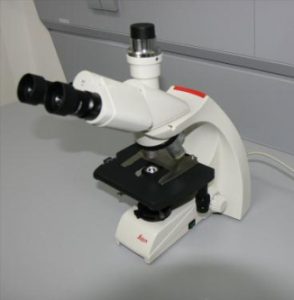
- achromatic plane 10x minimum aperture 0.22
- achromatic plane 40x minimum aperture 0.65
- semi-apochromatic plane with oill immersion 100x minimum aperture 1.30
The trinocular tube allows the installation of a 12 Mp DFC500 digital camera for microscopy to capture images. The microscope is equipped with 10x achromatic plane eyepieces and 5mm/0.5 mm reticles. It has an Abbe capacitor, with an aperture of 1, 25. The field aperture is adjustable for Koehler lighting. Also, it has a 0.63 x C-mount adapter for digital camera with sensor.
Leica M205A stereo microscope with DFC500 camera
The microscope is equipped with automatic motorization, for examination in transmitted and incident light. The purpose of this de vice is to observe the surface structures, allowing a magnification ratio of 20.5: 1 and a Zoom range of 7.8x-160x. 1.0x and 2.0x Planapochromat lenses allow a maximum magnification of 256x and 512x, respectively, with 16x eyepieces. The motorized column has a height of 620 mm, provided with motorized zoom and a motorized diaphragm for the field depth. The light source for the transmitted light is a 20W halogen bulb and a set of adjustable mirrors for dark field lighting and oblique lighting (phase contrast). Incident lighting source with 20W fiber optics. Camera resolution: 12 MPxl.
vice is to observe the surface structures, allowing a magnification ratio of 20.5: 1 and a Zoom range of 7.8x-160x. 1.0x and 2.0x Planapochromat lenses allow a maximum magnification of 256x and 512x, respectively, with 16x eyepieces. The motorized column has a height of 620 mm, provided with motorized zoom and a motorized diaphragm for the field depth. The light source for the transmitted light is a 20W halogen bulb and a set of adjustable mirrors for dark field lighting and oblique lighting (phase contrast). Incident lighting source with 20W fiber optics. Camera resolution: 12 MPxl.
Transmission Electron Microscope (TEM) FEI Tecnai G2 Spirit BioTWIN
The Tecnai G2 Spirit BioTWIN microscope allows the analysis of biological samples from animal  and plant tissues, also from organic and inorganic samples, being one of the basic research tools in the field of biology, medicine and cellular and molecular pathology. Guaranteed line resolution: 0.34 nm; guaranteed point resolution: 0.49 nm; maximum acceleration voltage of 120 kV; high voltages can be adjusted continuously or in 10 V steps in the range of 20 – 120 kV via the Graphical User Interface; the changing of the high voltage is done by software, in less than 1 minute; the stability of high voltage is better than 2 ppm/min. Calculated at the maximum acceleration voltage, the stability is 0.24 V/min. Magnification on the fluorescent screen in the range 22x – 340000x, continuous or in steps variable; the modification of the magnification is done without the rotation of the image obtained on the area of interest (rotation free imaging). The changing of the analyzed specimen is done in less than 30 seconds by keeping the vacuum in the column and without interrupting the high voltage or emission.
and plant tissues, also from organic and inorganic samples, being one of the basic research tools in the field of biology, medicine and cellular and molecular pathology. Guaranteed line resolution: 0.34 nm; guaranteed point resolution: 0.49 nm; maximum acceleration voltage of 120 kV; high voltages can be adjusted continuously or in 10 V steps in the range of 20 – 120 kV via the Graphical User Interface; the changing of the high voltage is done by software, in less than 1 minute; the stability of high voltage is better than 2 ppm/min. Calculated at the maximum acceleration voltage, the stability is 0.24 V/min. Magnification on the fluorescent screen in the range 22x – 340000x, continuous or in steps variable; the modification of the magnification is done without the rotation of the image obtained on the area of interest (rotation free imaging). The changing of the analyzed specimen is done in less than 30 seconds by keeping the vacuum in the column and without interrupting the high voltage or emission.
HansaTech LeafLab photosynthetic/respiratory performance determination system
The system is used for the study of photosynthesis and for respiration measurements by illuminating the 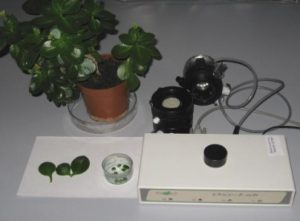 samples in the gaseous phase, being able to analyze leaves, algae, mosses or samples cut from leaves, with an area of up to 10 cm2. The control unit allows a wide range of applications such as mitochondrial and cellular respiration analysis, photosynthesis in chloroplast suspensions or foliar photosynthesis. Oxygen measurement is performed in the range of 0-40%, with a minimum resolution of 10 × 10-5 μmol/ml at 20°C. The measuring chamber is provided with an additional optical port for the simultaneous determination of chlorophyll fluorescence. The light source consists of 36 red LEDs with a maximum wavelength of 650 nm.
samples in the gaseous phase, being able to analyze leaves, algae, mosses or samples cut from leaves, with an area of up to 10 cm2. The control unit allows a wide range of applications such as mitochondrial and cellular respiration analysis, photosynthesis in chloroplast suspensions or foliar photosynthesis. Oxygen measurement is performed in the range of 0-40%, with a minimum resolution of 10 × 10-5 μmol/ml at 20°C. The measuring chamber is provided with an additional optical port for the simultaneous determination of chlorophyll fluorescence. The light source consists of 36 red LEDs with a maximum wavelength of 650 nm.
HansaTech ChloroLab3 Photosynthetic/Respiratory Performance Determination System
The system is used for the study of photosynthesis and measurements of respiration by illuminating samples in the liquid phase (algae, seagrass) in volumes up to 20 ml. The control unit is specially designed for determining the oxygen absorption and its evolution in the range 0-40%, with a minimum resolution of 10×10-6 μmol/ml, at a polarization voltage of 700 mV, being also provided with a magnetic stirrer, which ensures a speed range between 150-900 rpm and a reading acquisition rate of 0.2-10 readings/sec. The measurement of the incident light and the temperature inside the chamber can be performed in a range of 0-50,000 μmol/m2/s, in the range of 400-700 nm and between 0-50°C.
samples in the liquid phase (algae, seagrass) in volumes up to 20 ml. The control unit is specially designed for determining the oxygen absorption and its evolution in the range 0-40%, with a minimum resolution of 10×10-6 μmol/ml, at a polarization voltage of 700 mV, being also provided with a magnetic stirrer, which ensures a speed range between 150-900 rpm and a reading acquisition rate of 0.2-10 readings/sec. The measurement of the incident light and the temperature inside the chamber can be performed in a range of 0-50,000 μmol/m2/s, in the range of 400-700 nm and between 0-50°C.
HansaTech FMS2 Portable fluorimeter for chlorophyll
It is a pulse modulation fluorimeter that can be used to measure chlorophyll fluorescence emissions in a wide range of plant material during the photosynthesis process, in ambient lighting conditions (in the field). The light sources are represented by a modulated beam with a wavelength of 594 nm, with temperature compensation and 4 frequency control steps, a halogen dualscope lamp with actinic light (0-3000 μmol/m2/s in 50 steps) and pulse saturation (0-20000 μmol/m2/s in 100 steps) and 735 nm LED source for PSI preferential excitation. The detection is performed by analyzing the peaks of the fast pulses, at a sampling frequency of 10-20Hz, with the received data and the calculated parameters, drawing real-time graphs.
in a wide range of plant material during the photosynthesis process, in ambient lighting conditions (in the field). The light sources are represented by a modulated beam with a wavelength of 594 nm, with temperature compensation and 4 frequency control steps, a halogen dualscope lamp with actinic light (0-3000 μmol/m2/s in 50 steps) and pulse saturation (0-20000 μmol/m2/s in 100 steps) and 735 nm LED source for PSI preferential excitation. The detection is performed by analyzing the peaks of the fast pulses, at a sampling frequency of 10-20Hz, with the received data and the calculated parameters, drawing real-time graphs.
Leica RM2245 semi-automatic microtome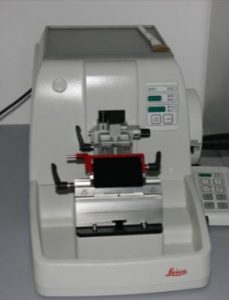
The Leica RM2245 semi-automatic microtome is used for making paraffin sections for histology and anatomy observations. The sectioning can be done in the conventional or “rocking” mode, the device being provided with support for histological cassettes, two wheel locking systems with handle and removable control panel, which allows the control of all the microtome functions. Shaping thickness range: 1-600 μm. Range of sectioning thicknesses: 0.5-100μm.
